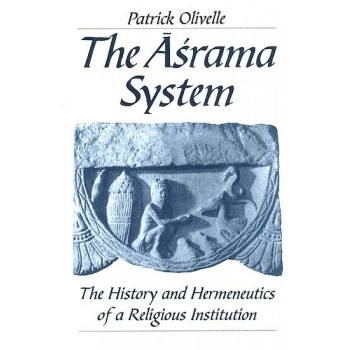Detail Of The Asrama System
| ISBN | 8121511356 |
| Pages | 288 |
| Language: | English |
| Product Code: | 1 |
| Size(in cm): | 9.3" X 6.3" cm |
| Weight(in grams): | 570(approx) |
Description:
CONTENTS
Abbreviations xi
Prologue
I. INTRODUCTION
3
1. Meaning and Method 7
1.1 The Meaning of Asrama 8
1.1.1 The Meaning of Srama 9
1.1.2 The Meaning of Sramana 11
1.1.3 Asrama as a Place and as a Way of Life 16
1.1.4 The Original Meaning of Asrama 19
1.2 The Meaning of the Asrama System 24
1.2.1 The System as a Theological Construct 24
1.2.2 The System as a Social Institution 27
1.3 Issues of Method 28
1.3.1 The System and the Institution 28
1.3.2 The Original Formulation and the Origin of the System 30
1.3.3 The Sources 33
1.3.4 The Asrama System and Brahmanical Hermeneutics
34
2. Background and Context 35
2.1 The Vedic Ideal of Religious Life 35
2.1.1 Marriage and Sacrifice 37
2.1.2 Marriage and Procreation 41
2.1.3 The Theology of Debts 46
2.1.4 The Theology of the Great Sacrifice 53
2.2 The Socio-Economic Context 55
2.3 Rival Views of Religious Life 58
2.3.1 The Emergence of a New World 62
2.3.2 The Householder and the Celibate 64
2.3.3 The Aryan and the Non-Aryan in Indian Asceticism
68
II. THE EARLY PERIOD
3. The Origins 73
3.1 The Original Formulation 73
3.1.1 Choice of Asrama 74
3.1.2 The Asramas as Permanent and Adult Vocations 78
3.1.3 The Three Celibate Asramas 80
3.1.4 Initiatory Studentship as Preparation for the Asramas 80
3.1.5 Who Was Entitled to Choose as Asrama? 81
3.1.6 The Order of Asramas 82
3.2 Controversy and Debate 83
3.2.1 The Legitimacy of the Asrama System 83
3.2.2 The Debate over Relative Superiority 91
3.3 Authorship 94
3.3.1 Was the Asrama System a Defense of Orthodoxy? 94
3.3.2 The Asrama System as a Theological Innovation 96
3.3.3 Kapila, Samkhya, and the Asramas 98
3.3.4 The Purpose of the Asrama System 100
3.4 Date 101
3.4.1 The Silence of the Ramayana 103
3.4.2 The Silence of the Bhagavad Gita 103
3.5 The Pre-History of the Asrama System and the Question of the Three Asramas 106
4. Ingredients of Change 112
4.1 The Third Asrama and the Problem of the Hermit 112
4.1.1 The Special Provisions of Apastamba 113
4.1.2 The Institutions of Old Age 114
4.2 The Fourth Asrama and the Time of Renunciation 117
4.2.1 The Time of Renunciation in the Samnyasa Upanisads 117
4.2.2 The Time of Renunciations in Deutero-Baudhayana 119
4.2.3 Renunciation and Old Age 120
4.3 Ritual Appropriations of Renunciation 122
4.3.1 Renunciation as the Abandonment of Ritual 122
4.3.2 Renunciation and the Rite In Extremis 123
4.4 The Asramas and the Rites of Passage 126
III. THE CLASSICAL PERIOD
5. The Classical Asrama System 131
5.1 Description of the Classical System 131
5.2 The Hermeneutics of the Classical System 134
5.3 The Classical System in the Smrtis 136
5.3.1 Manu 137
5.3.2 Yajnavalkya 142
5.3.1 Visnu 144
5.3.1 Vaikhanasa Smartasutra 145
5.3.1 The Mahabharata 148
5.4 The Original System in the Classical Period 151
5.4.1 The Arthasastra 151
5.4.2 The Mahabharata 153
5.4.3 The Purannas 155
5.4.4 Miscellaneous Sources 158
5.4.5 Medieval Theologians 159
6. Development of the Classical System 161
6.1 Classifications of the Asramas 161
6.1.1 Early Classifications of the Four Institutions 162
6.1.2 Formal Classifications of the Asramas 165
6.1.3 Hermeneutics and the Classification of Renouncers 170
6.2 Modifications of the Classical System 173
6.2.1 Skipping the Third Asrama 173
6.2.2 Renunciation as an Exception to the Classical System 177
7. The Asramas and Other Brahmanical Institutions 183
7.1 Gender and Asrama 183
7.2 Varna and Asrama 190
7.2.1 Status of the Sudras 192
7.2.2 Varna and Renunciation 195
7.3 The Asramas and Civil Authority 201
7.3.1 The King as Guardian of the Asramas 201
7.3.2 The Asramas, Ascetics, and the Law 204
7.4 Parisad and Asrama 210
7.5 Asrama and Other Aspect of Dharma 214
7.6 Sets of Four: The Purusarthas and the Asramas 216
8. The Asrama System in Medieval Theology 220
8.1 Anasramin: Obligation to Live in as Asrama 220
8.2 Atyasramin: Transcendence of the Asrama 222
8.3 The Question of a FifthAsrama 232
8.4 Asrama and the Doctrine of Yuga 234
8.5 The Legitimacy of the Asrama System: The Continuing Debate 237
Epilogue 244
Bibliography 247
Index 263
Reviews (0)
Write a review
Your Name:Your Review:
Note: HTML is not translated!
Rating: Bad Good
Enter the code in the box below:



 |
| 